A woman at any age wants to be attractive. The appearance of gray hair becomes an unpleasant event for her. Let's look at how to cover gray hair with henna and basma, and also consider in detail the properties of natural dyes.
Advantages of natural dyes over synthetic ones
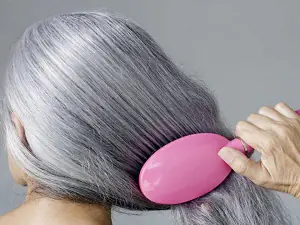
Synthetic hair dyes contain harsh chemicals that destroy the natural pigment of the hair and color it with artificial dye. The result after coloring gray hair with store-bought dye is visible almost immediately, but very often you have to pay for it with your beauty and health. Chemical dyes dry out the hair, making it brittle and dull, and the scalp suffers from them. Often, aggressive dye substances destroy hair follicles, which leads to hair loss.
Today it has become very popular to use natural ingredients in the preparation of cosmetics. Nature has long created everything necessary; man only needs to be able to use it. Henna and basma powders, which have long been used to maintain natural beauty by both women and men, are successfully used to color gray hair.
Henna and basma are classified as herbal dyes of plant origin. These plants contain a lot of complex substances, such as alkaloids, resins, essential oils, tannins, which have a beneficial effect on the condition of the scalp and, accordingly, hair.
Advantages of dyeing gray hair with henna and basma:
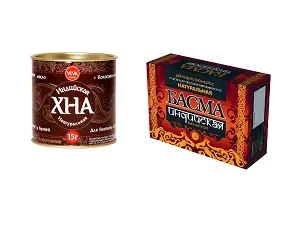
- With regular use of dyes, hair becomes thicker and stronger.
- The scalp receives nutrients.
- Henna and basma help eliminate dandruff.
- The color from the use of natural dyes is rich and very durable.
- These products are practically hypoallergenic.
- Both henna and basma are widely available and are very cheap, especially in comparison with store-bought dyes.
Regular dyeing of gray hair with natural dyes will not only give your hair a beautiful rich color, but will also improve your hair’s health, making it pleasant to the touch, shiny and silky.
How to use henna and basma to cover gray hair
Using vegetable dyes in combination with other natural ingredients, you can get different shades. Basma, when dyed, gives a darker color than henna, and professional hairdressers recommend starting with the second color. The important thing is that basma should always be combined with henna for covering gray hair. Otherwise, the hair may acquire a greenish tint. Combining these two products allows you to get a rich, dark color from light chestnut to black.
The technique for coloring gray hair with natural products is similar to that when using synthetic dyes.
Let's look at some rules of the painting procedure:
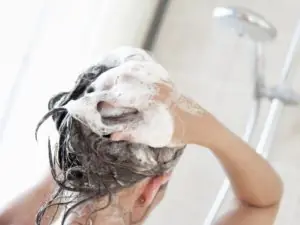
- Before you start painting, you need to wash your hair well with simple shampoo without conditioner. The head must be clean before applying paint.
- You first need to apply a layer of rich cream to areas of the skin that may get paint. This is necessary because henna and basma applied to bare skin are difficult to wash off and can leave stains.
- Henna and basma paint can be prepared in plastic or ceramic containers. It is better not to use metal bowls, as some components of the vegetable dye may react with the metal.
- The prepared mixture is applied with a brush or sponge first to the roots, and only then distributed along their entire length.
- At the end of the procedure, you should wrap your head with film and a towel - in the warmth, natural dyes will react better with the scalp, nourishing it.
- Henna dyes gray hair effectively if you keep the dye on your head for an average of 2 hours (the time varies depending on the desired result).
- The paint is washed off with running water. Under no circumstances should you use shampoo, as the entire result will immediately disappear.
- As a rule, the final result after the procedure will appear on the 2-3rd day, so do not be upset if you do not immediately see what was planned.
- The procedure for coloring gray hair with henna and basma is not recommended more than once a month. Otherwise, the color of your hair may become dull. When gray roots grow back, you can simply paint them over.
Expert advice
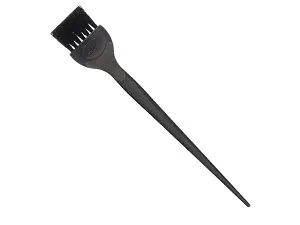
Dye powder must be stored in a dark, dry place. As mentioned above, henna and basma are very persistent dyes, so dishes, bathtubs and other objects and surfaces with which the dye mixture has been in contact should be washed immediately.
Natural dyes contain a lot of tannins, which can dry out your hair. If you have dry or normal hair, when preparing the dye, you can add 1 egg, 1 tsp. oil or 2-3 tbsp. kefir
Depending on the proportional ratio of henna and basma in the prepared dye, you can achieve different shades for your hair. Here are a few proportions that will help you get this or that effect after coloring your gray hair:
To get light brown hair, you should mix henna and basma powders in a 1:1 ratio and leave on your hair for half an hour.
To obtain a light chestnut shade, the same proportion is used, but the paint is aged for an hour.
A rich chestnut color will be obtained if you take 2 parts basma to 1 part henna. Leave the mixture for 90 minutes.
Shades of bronze after dyeing can be obtained by taking 2 parts of henna and 1 basma, and do not wash off the paint for 90 minutes.
For black color, take 3 parts basma and 1 henna. Leave on hair for 4 hours.
When you see gray hairs on your head, do not rush to the store for aggressive synthetic dye. Think about the gifts of nature that can be successfully used to maintain beauty and youth.

- June 27, 2018
- Care
- Svetlana Morozova
The appearance of gray hair for a woman is akin to a universal catastrophe. That’s why so many people want to use professional paint to paint it over. But experts in the field of studying hair and scalp conditions (trichologists) know that gray hair is an irreversible phenomenon and is associated with age-related changes. But even a young girl can see several whitened locks if she has experienced a severe nervous shock or has been seriously ill for a long time. The hair follicle contains special cells - melanocytes, which are responsible for the natural color of the hair. As soon as they stop producing pigment, then gray hair appears. Of course, you can use an ammonia-based dye. Such dyes quickly and successfully cover even the whitest curls, but they certainly don’t add health to the hair. And it is not recommended to use them constantly. To get rid of gray hair and improve the condition of your hair, you can use henna and basma, and gray hair will no longer be a problem on a global scale.
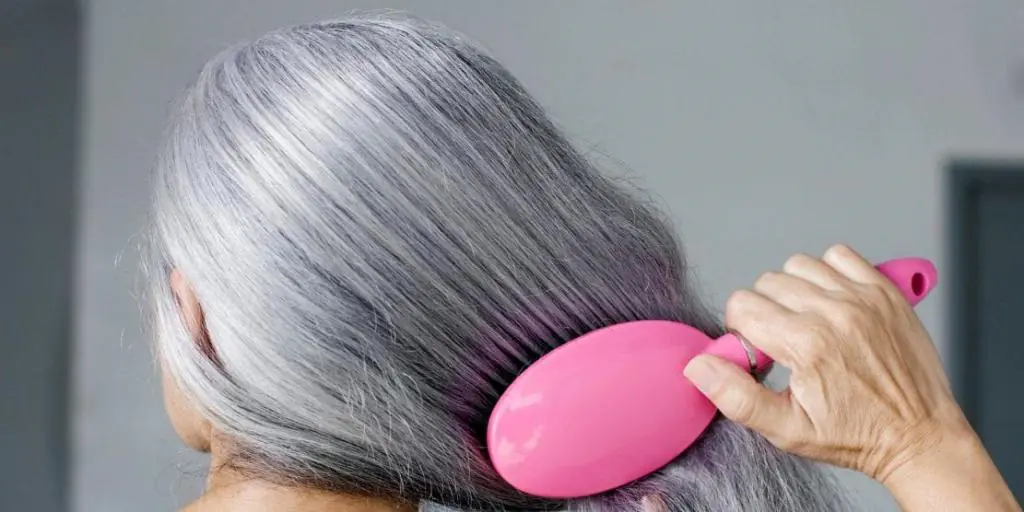
What is henna
It is an absolutely harmless dye, which is made from natural raw materials. For this, lawsonia leaves and alkanes are used, which are ground into powder. These plants are native to Sudan, Syria, India, Egypt, and North Africa.
If you dye gray hair with henna, you can get a fiery red color. Of course, not all women dream of such a shade, so the product is often mixed with other natural substances:
- to obtain a chestnut or chocolate shade, cocoa powder or coffee is used;
- if you want to get curls with a blue-black tint, then basma will come in handy.
You can purchase henna in three different forms:
- regular powder;
- pressed powder;
- in the form of a liquid.
It is better, more effective and healthier to dye gray hair with henna using a product in the form of regular or pressed powder.
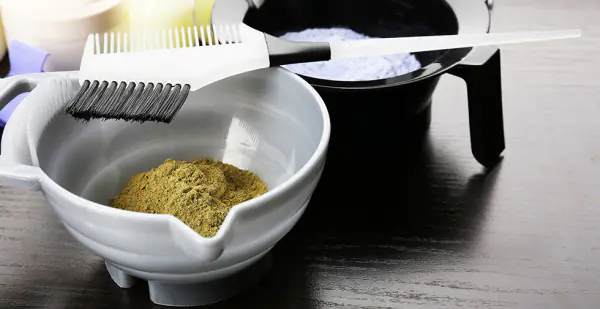
Advantages of henna
The main advantage of henna is its safety and naturalness. It has an extremely beneficial effect on hair and scalp. Among the impacts it has, the following points can be highlighted:
- disinfectant effect:
- health-improving;
- anti-inflammatory;
- restorative;
- wound healing.
Dyeing gray hair with henna turns out to be an indispensable option for people who cannot stand products with a chemical component or are allergic to them. In addition, ammonia can greatly irritate the scalp, which cannot be said about natural dye. Among the advantages of henna, women also highlighted the ability to use it to get rid of dandruff and restore hair damaged by thermal styling.
The opinion of trichologists
Dyeing gray hair with henna is recommended by experts in the field of hair research. This is a natural dye that has no age restrictions for use. Trichologists have long identified the main advantages of the powder; they recommend it to their patients because:
- henna normalizes the functioning of the sebaceous glands, eliminating excess fat and dandruff;
- ensures accelerated hair growth and natural volume;
- improves blood circulation in the scalp;
- protects hair from the harmful effects of ultraviolet radiation.
There are also disadvantages
Henna is a natural dye that has its own specific disadvantages. Among them, the following are especially significant for women:
- gray hair may remain after dyeing;
- the functioning of the sebaceous glands is normalized, but the strands may become dry;
- if henna was used, then ammonia-based dye cannot be used earlier than three months later.
Let's consider Basma
The product is obtained from crushed indigofera leaves, so it is also a natural dye, useful for hair growth and nutrition. If we turn to ancient sources, we can see that a dye was previously made from this substance, which was used to dye fabrics. Much later, basma began to be used for cosmetic and medicinal purposes.
The powder contains a lot of tannins, which:
- add shine to hair;
- endows them with strength and strength;
- accelerate growth.
However, single-component dyeing of gray hair with basma is not practiced. If you use only this substance, you can get a blue or green tint to your curls. But basma is ideal as a supplement.

Union of two dyes
Henna and basma and gray hair are a perfect union. Experts note that graying hair has a different structure and becomes more porous. In the place where the pigment should be, voids are formed. A mixture of henna and basma successfully fills them, while not only healing the hair, but also giving it a noble shade.
Over time, the dye is washed off from the hair, but since the powder is harmless and natural, it can be used quite often, which cannot be said about dyes based on chemical components. Moreover, the hairstyle only becomes healthier, and the curls are amazing in their volume.
To dye gray hair, henna is used as a basis, and basma is used as an additional component to guarantee the desired color.
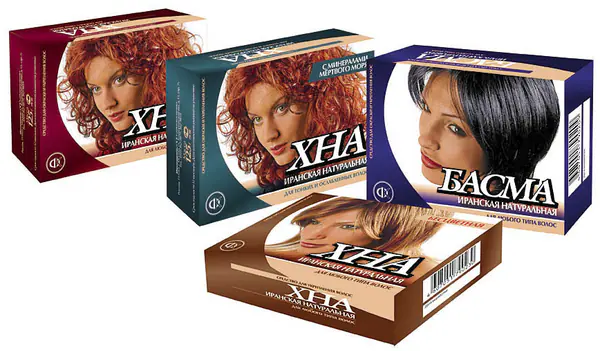
Types of henna
Henna and basma and gray hair were previously considered signs of grandmothers. However, now even younger women prefer to use health-improving paint, because the assortment pleases with the choice. You can always choose the most optimal option.
The dye can be of three main types:
Brightening henna. Used to give hair a lighter shade. With its help, you can achieve lightening by 1-1.5 tones. Must be used in combination with hair oils.
Colored. The most popular type of henna, it is in great demand among women of all ages. Can be used on curls of any color and with gray hair. If gray hair is dyed with henna and basma, then with the right combination you can get:
Colorless. This henna is not suitable for covering gray hair, but is widely used for preparing medicinal masks. Used as a healing and strengthening mixture.
Choosing a manufacturer
Coloring gray hair with henna and basma will be most successful if you select all the components correctly. The manufacturer of the powder is no less important, because natural raw materials, depending on the region, are somewhat different:
1. Indian henna. It stands out for its useful properties, but has a small range of colors.
2. Turkish henna is often found on sale, is inexpensive and has all the advantages of a natural dye.
3. Iranian. Fashionistas know that the best henna is Iranian-made powder. It covers gray hair well, revitalizes curls and is able to give your hair different color schemes.
You can often find henna in liquid form on sale. Judging by the reviews, it is convenient to use, but the result is often uneven coloring.
Mixing Instructions
In ready-made ammonia-based paints, all components are contained in calculated proportions. In the case of natural dye, you need to calculate everything yourself.
Dyeing gray hair with henna and basma requires different times and different proportions. It all depends on what result the woman wants to get:
1. Red and fiery shade. To do this, you need to mix henna and basma in proportions of 2 to 1. If you keep the mixture on your hair for 30 minutes, you will get a red color with a red tint. If you extend the exposure time to an hour, your hair will become fiery red. You can keep the powder on your hair even longer, then you get the effect of sparkling rust.
Many women advise using chamomile decoction instead of water to brew the mixture. This nuance further promotes health and gives a golden hue to the hairstyle.
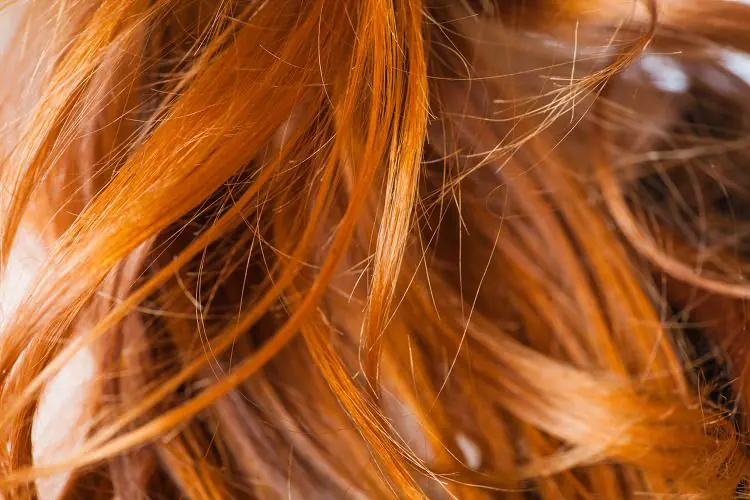
2. Chestnut color. This shade can be obtained by using different proportions of henna and basma. Gray hair will acquire a lasting shade if you mix both components in a ratio of 1 to 2 or 1 to 3. If you leave the mixture for about half an hour, you can achieve a light chestnut tint. When kept for up to an hour, a persistent brown color is obtained. If you do not wash off the mixture for up to four hours, a persistent chestnut shade will emerge.
Reviews show that by adding two teaspoons of coffee or cocoa to the finished coloring mixture, you can get an elegant chocolate tint.
3. Dark brown color. It is obtained by mixing henna and basma in a ratio of 0.5 to 2. Fashionistas sometimes add beet juice to get garnet-colored curls.
Dyeing gray hair with henna and basma has its own nuances. You won't be able to get a deeper, richer color right away. To do this, you will need to carry out several sessions of coloring them.
Rules for using the mixture
Dyeing gray hair with henna and basma is not entirely simple and requires following some rules. It should be noted that any natural dye oxidizes in a metal container, so it is necessary to use a container made of glass, ceramics or wood. Below are a few more rules:
- Be sure to use protective gloves. Otherwise, not only your hair, but also your hands will be stained.
- To protect your forehead, ears and neck from staining, you can generously lubricate these areas with any cream.
- The procedure must be carried out only on clean hair. This also distinguishes natural powder from industrial paint.
- Apply the mixture to damp hair using a comb.
- It is important to know how to dye gray hair with basma and henna, because otherwise you can get an uneven shade. Staining should begin from the back of the head. Then smoothly move to the forehead area, gradually capturing the temple area.
- For intense coloring and healing properties, it is important to retain heat. To do this, after painting, you should put on a protective cap and wrap your head with a towel.
- It is not recommended to use shampoo after the procedure and the next day. The curls just need to be rinsed thoroughly with running water. It has been proven that during this time the effects of plant components continue.
- To make the color more intense, it is necessary to add components with high acidity. This could be pomegranate juice, red wine or a drop of lemon.
To dye gray hair with henna and basma, you need to use only a warm mixture. Otherwise, the effectiveness of the procedure is noticeably reduced, as confirmed by numerous reviews.
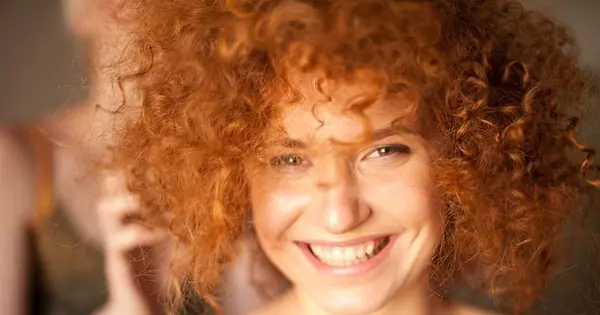
How to color gray hair with henna and basma
It must be remembered that natural dye can also provoke an allergic reaction. Therefore, before first use, it is important to carry out a control test. To do this, you should try dyeing on a small strand of hair. In addition, this approach will allow you to understand how long it is necessary to keep the mixture on your curls. Dyeing gray hair with henna and basma can be done in two ways.
Henna and basma separately
This method is recommended for those who have a lot of gray hair, or colorless hair is unevenly distributed over the head.
First henna is applied:
- In a glass or ceramic bowl, you need to dilute a henna bag with warm water. If your hair is short, then one is enough, if your hair is long, then you will need two.
- The water should be around 80 degrees. Steep boiling water destroys all the beneficial properties of plants.
- It is important to distribute the mixture evenly throughout the hair.
- It is important to insulate your head with a special hat and towel. You can use a plastic bag.
After washing off the henna, you need to apply basma. In this case, the cap and towel are no longer used. The exposure time directly depends on what color you want to get, which was discussed just above.
Shampoo is not used to rinse off. But to facilitate the removal of basma from hair, the use of balm is allowed.
Henna and basma together
Henna and basma and gray hair are great friends with each other. If gray hair is just beginning to appear in small quantities, then you can use a mixture of powders to eliminate it. The products are mixed in the required proportions using water or chamomile decoction heated to 80 degrees. It is important to apply the coloring composition from the very roots and touch the ends. In order for the mixture to act more intensely and the coloring result to be satisfactory, it is important to ensure the preservation of heat. For this, polyethylene and a towel are used.
Natural dye quickly fills the voids of gray hair. It is important to rinse the mixture well, but do not use shampoo. There are a few more rules that are important to follow:
- Before dyeing, it is important to wash your hair and not use conditioner;
- procedures must be carried out on dry and clean hair;
- It is not recommended to use a hair dryer after dyeing.
It is important to correctly observe the proportions and exposure time, so as not to ruin your mood with an unpleasant shade of hair.
Recommended holding time
Henna and basma are natural dyes, so you can keep them on your hair as long as you like. However, the exposure time will directly depend on the desired hair color. The recommended time is between half an hour and four hours. It is noted that the longer the mixture is on the hair, the more intense and brighter the final shade will be.
Many people are interested in the question: “Can henna and basma cover gray hair the first time and how effective?” It should be taken into account that the result is largely determined by the type of hair and its structure. If the strands are soft, then the coloring pigment penetrates quickly and deeply into them. When curls are stiff, the desired result can be achieved with several procedures and longer exposure.
It is also important to consider how gray hair is distributed on the head. If it appears in patches, then the coloring will be uneven. Reviews confirm that hair that was gray becomes intensely red, and pigmented curls become orange in color. This is why it is recommended to use henna first, and only then basma. In this case, you can achieve a uniform effect the second time.

Little tricks
Experienced women who constantly use natural raw materials for hair coloring know small tricks for a successful procedure:
- You can always determine the quality of henna before applying it. After brewing it should be a bright red color.
- To make it easier to apply the mixture and provide additional nutrition to your hair, you can add raw yolk.
- If your hair is too dry or brittle, you should add olive oil or kefir.
- Reapply the mixture to regrown hair only at the roots. Otherwise, the curls will be unevenly colored.
- To get a beautiful honey shade, you can add saffron, turmeric, and rhubarb decoction to the mixture.
- The chestnut color is obtained by adding ground cloves, buckthorn or cocoa to henna.
- Basma with the addition of coffee gives an intense black color.
- The burgundy color that many people like can be obtained by adding hibiscus infusion.
If your hair is completely gray and you need to get the darkest possible color, then it is recommended to use henna on the first day and only apply basma the next day.
Reviews about coloring
Quite often, henna with basma is used for gray hair. Reviews show that the product is effective, but there may be an unpredictable result when staining for the first time. Obvious advantages include safety, therapeutic effect and permanent coloring. But there are also some disadvantages. Sometimes the shade is too intense or the gray hair is not covered at all. It takes longer to achieve a good result than with ammonia-based paint. Not everyone is happy with the smell of natural dye. Also, with prolonged use, the hair can become dry.
Conclusion
It is important to choose the right natural dye. The packaging must contain information about the composition and manufacturer. From the reviews it is clear that paint of Iranian origin gives a more saturated color. Plus, it lasts longer than others.
Fresh henna and basma should be marsh color. If they have a yellowish tint, then the expiration date may have come to an end. However, the result may not be as pronounced as we would like.
With the help of henna and basma, you can successfully get rid of gray hair and give your hair a healthier and shiny look. It is important to know the subtleties of mixing, but each woman comes to her own shade based on numerous experiments.
Henna is a home remedy that maintains the natural beauty of hair and also restores its original appearance. We are talking about how to dye gray hair with henna. Natural remedies such as henna and black tea, especially for gray hair, will give the hair pigment, strength and the same healthy shine.
Mehendi, also known as henna, will not only color your hair, it will make it thicker, stronger and silkier, the tea will give it a special deep pigment. Dyeing gray hair with henna has its drawback; you will need to dye gray hair with it more often than with dye.
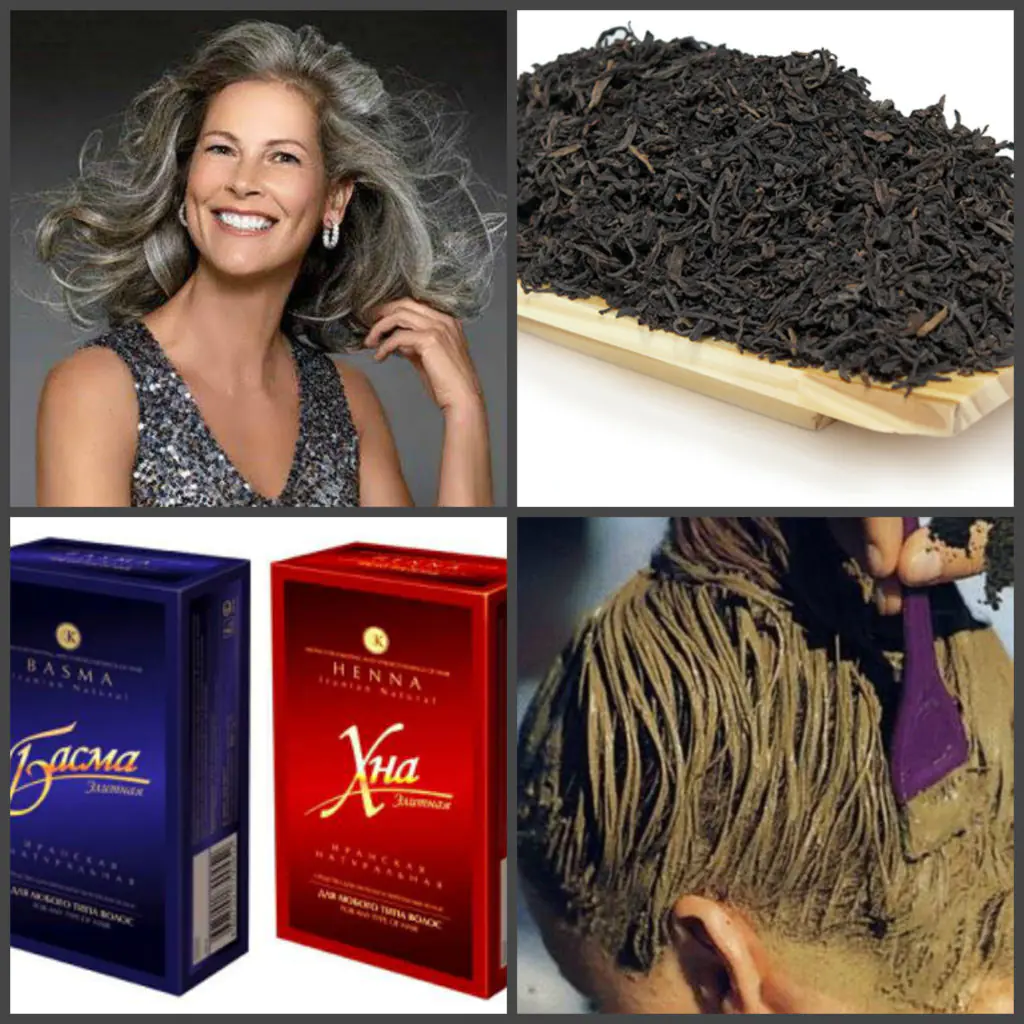
Does henna cover gray hair?
– henna perfectly colors gray hair, especially in the initial stages. To dye completely gray hair, you must also use basma. Do you doubt it?! This is very in vain, because our grandmothers dyed their hair only with the help of nature, without chemical pigmentation.
First, we will determine your type of gray hair in order to calculate the time and type of dyeing gray hair with henna.
Gray Hair Types:
- Initial type of gray hair – initial gray hair is gray hair that fills less than a quarter of the hair.
- Average type of gray hair - the average type of gray hair is almost half of the gray hair.
- The final type of gray hair is that all hair is covered with gray, meaning all hair is devoid of pigment.
In the first two types, gray hair is considered focal, that is, partial. The first two types are easy to dye with henna.
The full type of gray hair is most often diffuse, that is, the hair gradually loses its pigment.
When your hair begins to turn completely gray, you need to use henna with the addition of basma and leave it on your hair longer.
On average, to get rid of gray hair, you should apply a mixture of henna and tea every two to three weeks. There are many side effects from regular hair dyes. Here at whair articles, we always recommend care products that are gentle on your hair. Women who often use hair dyes know that this often leads to dry, itchy and flaky scalp, while henna nourishes the hair making it soft, silky and beautiful.
Natural henna with the addition of other components will allow you to get different shades from dark chocolate to red or red.
Dark brown color after dyeing with henna and tea before and after photos:
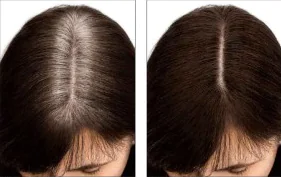
- The best way to apply henna is to use a dye brush, dividing the strands into sections, just like with regular dyeing, starting at the roots and working towards the lengths and ends.
- After applying henna, wear a cap or wrap your hair under a towel to create heat to open the hair cuticles. In warmth, the dye penetrates deeper and pigments the hair more deeply.
- It is very easy to wash off henna from hair that has already been dyed with it, first wash it off with just water, and then wash your hair with shampoo and conditioner.
The result of dyeing with henna, tea and basma before and after photos:
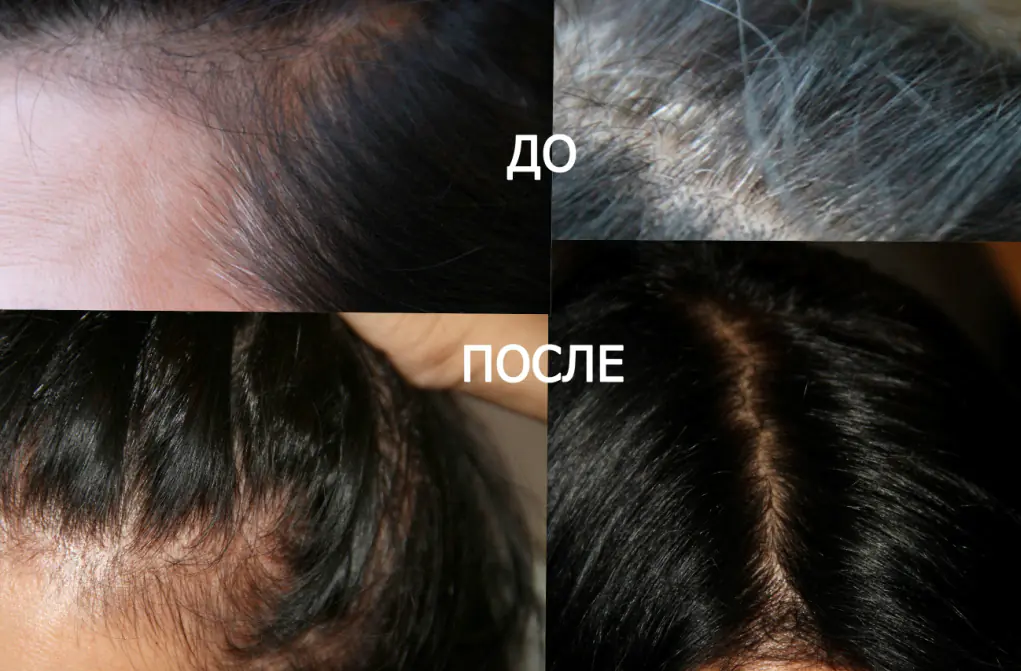
You should only use “natural” henna powder, which is usually light green in color. Stay away from packaged henna, which usually contains synthetic ingredients. If you come across a product where the colors are already pre-mixed, read the label carefully. If it says it is 100% pure henna, it is not. Although there are good products with henna and herbal blends, try to shop around and buy a pack.
How to prepare a mask for coloring gray hair with henna:

Natural henna, black tea, lemon- Water
- Medium pasta bowl (use an old bowl, it will get dirty)
- Towel
- Shower cap
- Gloves, comb and hairpins
- Conditioner and shampoo
If you have not used henna before, then you need to do a trial test on one strand.
How to get rid of gray hair at home with this folk remedy?
Follow the recipe steps below. This way you can color your gray hair correctly. They are very simple and don't require much effort!
Step 1: Brew black tea
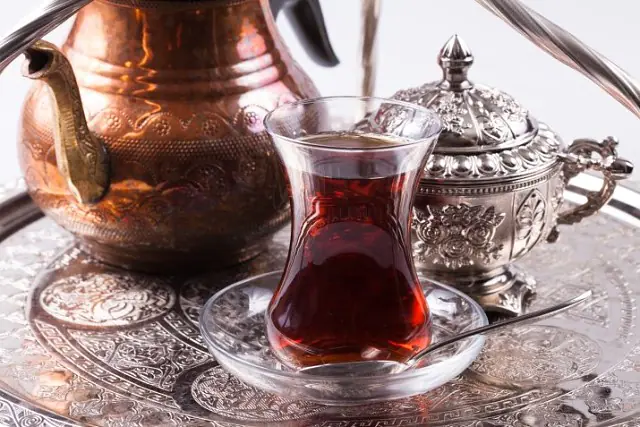
The first and most important thing you need to do is brew loose leaf black tea. Take 2 tablespoons of black tea and pour 0.5 liters of boiling water, leave until the tea cools to room temperature.
Step 2: Prepare an anti-gray mask with henna
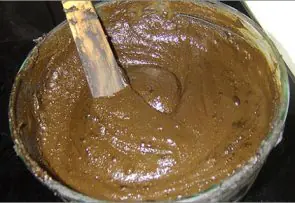
The next thing you should do is prepare a henna mask. Take 2 tablespoons of henna and pour tea over it to obtain the consistency of liquid sour cream. This mask will give gray hair a dark brown or chocolate shade, depending on how soft your hair is. If you are against the redness that paint can give, add lemon juice (4 parts lemon will be enough). Mix well. If you have a lot of gray hair or almost complete gray hair, take 1 tablespoon of henna and 1 tablespoon of basma, but in this case do not add lemon juice.
Step 3: Apply the mask
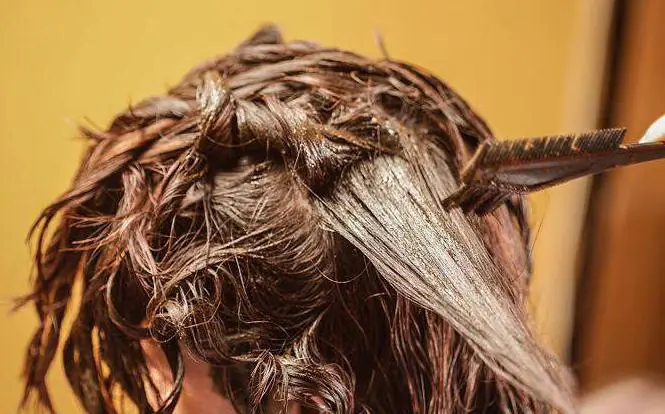
Section your hair to make it easier to apply the gray hair coloring mask. Apply the mask using a brush and secure your hair. Carefully color all your hair. Make sure there are no untreated areas.
Step 4: Remember to wait
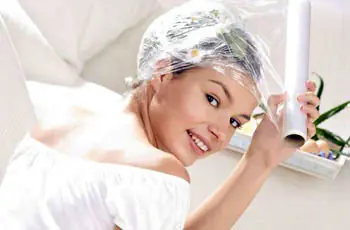
Be sure to create a greenhouse effect with a towel and a cap so that gray hair absorbs the henna pigment as deeply as possible, the result of coloring gray hair depends on this. You will have to wait from 1 to 2 hours, if you have soft, thin hair, then an hour will be enough for the gray hair to be dyed. If your hair is coarse, then you will definitely have to wait an hour and a half, then go through your hair and see the result, wash off the henna or keep it on for longer. Take this time to relax! Give yourself a good pedicure. Read a magazine or, of course, do household chores, but we recommend that you pay attention to relaxation.
Step 5: Wash off the mask
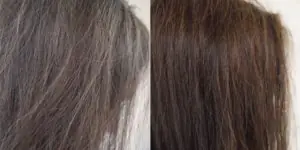
After your time of coloring your gray hair, you can wash your hair. Make sure you wash off any henna residue thoroughly. Rinse the henna off with cool water before washing. It will give a healthy shine to your hair. After washing with shampoo, use conditioner. Use gloves when washing off henna. Massage your head well. Repeat the process if you are not sure.
Now you have finished dyeing gray hair with henna. You will really like your hair.
More recipes for hair coloring with natural home remedies video:
Have you already used henna for gray hair? What are your impressions? Share your experience with us.



